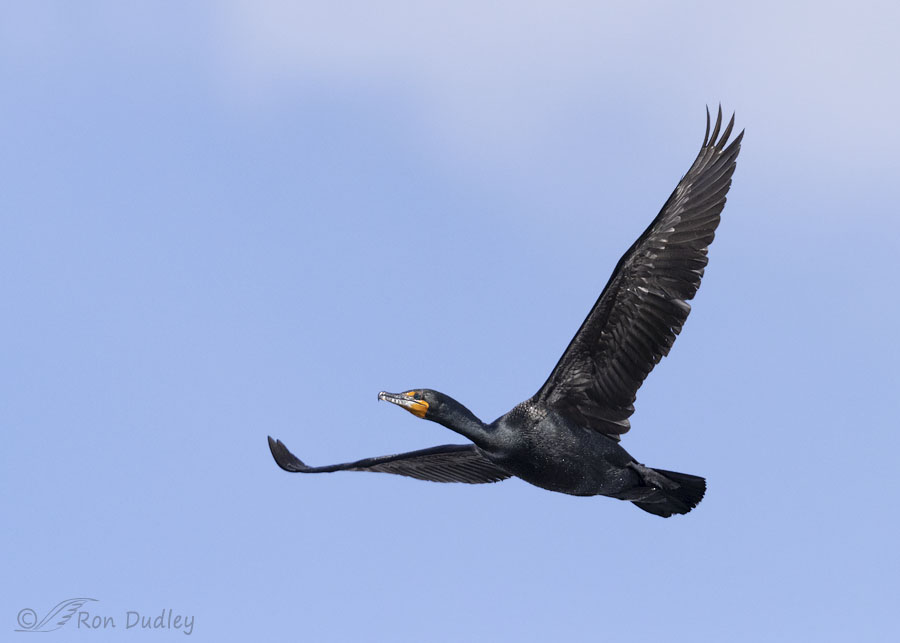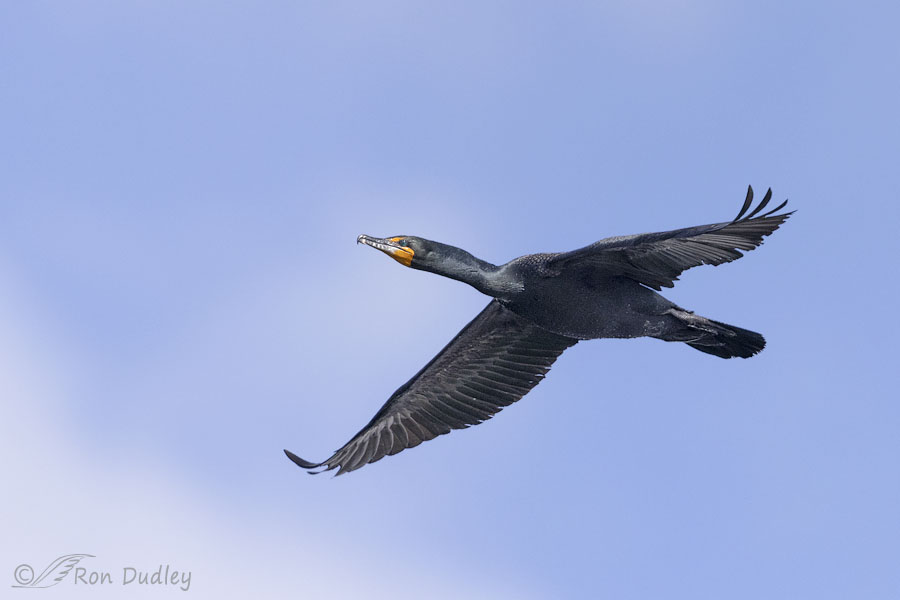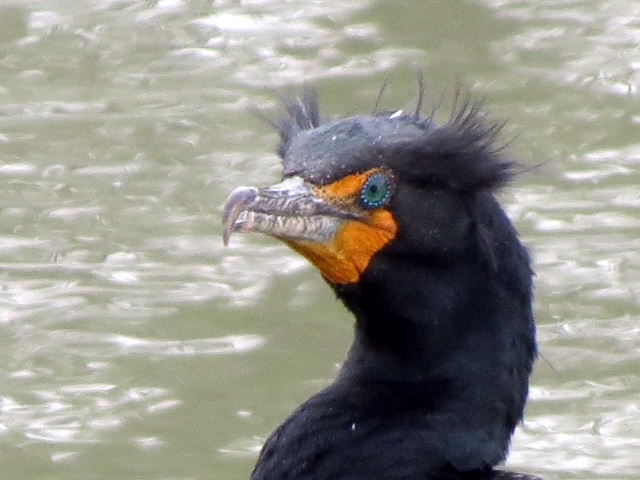A human lucky charm for grab shots?
Yesterday I posted a couple of grab shots of a Great-tailed Grackle taken from my pickup while I was talking to my friend Shane Smith, who was standing right next to my window as we were jabbering. Seconds later I got more grab shots of a different species, this time in flight.

1/8000, f/6.3, ISO 640, Canon R5, Canon EF500mm f/4L IS II USM + 1.4 tc, not baited, set up or called in
While we were gabbing I spotted this Double-crested Cormorant flying over the pond so I raised my lens and got quite a few sharp photos of it in flight. As I recall I was talking to Shane and shooting at the same time – usually not a good mix.
Readers know that plain blue sky isn’t my favorite background but this time there were some intermittent puffy white clouds behind the bird so I hoped to get a mix of blue sky and white clouds in some of the shots. But at my focal length my field of view is extremely narrow and the cormorant mostly stayed in front of blue sky. So I only got a few shots with a mix of blue and white in the background and these are two of them.

1/8000, f/6.3, ISO 640, Canon R5, Canon EF500mm f/4L IS II USM + 1.4 tc, not baited, set up or called in
Eight frames in the burst later I got this shot that included a little more of the white clouds. It was about at this time that Shane raised his camera and took some photos of the cormorant too. But if I remember correctly (maybe I don’t?), his shots would have had only white clouds behind the bird, with no blue. That’s a very difficult exposure, especially with a black bird.
I know, two days in a row now I’ve posted photos of birds that a lot of folks don’t like – grackles and cormorants. But they both have feathers and they’re both native so for me they’re fair game.
Maybe I should ask Shane to tag along on more of my birding adventures. He seems to be a lucky charm when it comes to increasing the success rate of my grab shots. Usually they’re mostly garbage.
Ron
Addendum:
In a comment below, Kris Eberhard asked to see a photo that shows the crests of this species. When Dan Gleason saw what she said he sent me one, along with the following note. Thank you, Dan.
“Somone asked about cormorant crests. It’s a frequent question I get. When I talk about cormorants in my presentations I usually include this photo so everyone can see why it’s a Double-crested Cormorant. Feel free to share with anyone if you wish.”

Copyright Dan Gleason


I usually do not comment, but, I do enjoy all your bird pictures , adventures, and your health updates. You have good commentary– Thanks==
Good to know you’re out there, Mike. Thanks.
The bird is beautiful. As you describe your grab shots, I am picturing a photographer we met at Bosque del Apache a couple of years ago. My sisters and I interrupted him shooting murmurations of starlings on the flight deck, and he very kindly stopped to answer our questions. He was holding his enormous camera/lens kind of casually by his side and occasionally glancing over the field at the birds while still focusing on our conversation. And every once in a while, he’d swing the camera up and shoot a bit, and then the camera would come back down to casual position. The ease and total competence with which he did it were very impressive. And that’s how I’m picturing you – gabbing with your friend, watching the sky, swinging your camera up to “grab” a shot! Whew, what a wonderful image!
Yup, that’s pretty much what I was doing, Carolyn The difference is that your photographer was presumably on foot while I was in my pickup.
Thanks, Dan ! Thanks, Gary ! Thanks, Ron ! Now I know– the crests are quite
ornamental in a restrained way…….I love the way the FP posse is so
quick to share with other members, and Ron is very generous to facilitate
the pass-on info. A VERY CLASSY BUNCH ….I look forward to every morning’s post.
Much appreciated, Kris. As you suggest, it’s a team effort.
A great neighbour, friend and a lucky charm.
Your grab shots exceed (by a very long way) anything I can hope for. And how I love these sinuous shots of the cormorant.
Yup, all three. Thanks, EC.
Sounds like Shane is a lucky charm in more ways than one — what a great neighbor and friend! Still marveling at your grab shots too. These shots definitely show off the graceful, beautiful lines of a cormorant in flight.
“what a great neighbor and friend”
He certainly is that, Marty. And maybe a lucky charm too…
Nice grab shots, and sounds like a fun day too. I like both birds, hell I am about to post photos of a female Canada Goose I photographed in St George. I like a post Haley shared a few days ago, I think I’ll add it here if you don’t mind, you can remove it if not appropriate.
https://www.audubon.org/news/meet-little-brown-bird-holds-mirror-humanity
Thanks, April. I post photos of Canada Geese fairly often. Personally I just can’t see myself posting photos of House Sparrows but including the link you provided is just fine.
I hope that you’ll get a shot showing their crests at some point–don’t have any clue as to what they look like……blue sky surely accents the striking orange of their beak coloration…….
Kris, a few days ago a friend of mine got a shot of a cormorant that shows its crests quite well. If you’re on Facebook you can see it here:
https://www.facebook.com/photo/?fbid=10227518673646370&set=pcb.10227518698126982
Neat!
Also, see the addendum I’ve added.
The crests are single or multiple white plumes on breeding adults at the top of the head above and behind the eye. They can be quite showy. I had a pretty good photo of them from several years ago but I cannot find it now. Cornell “All About Birds” has a good photo of them here:
https://www.allaboutbirds.org/guide/Double-crested_Cormorant/photo-gallery
Thanks for the link, Gary.
There is often variation between individuals and different populations and this can be confusing. The crests are seasonal and are above and behind the eye. These are short contour feathers and are variable in length and color. Some western birds actually show more white than black. The longer white feathers atop the head of some individuals (but not all) are actually long filoplumes and not the “crests” which give rise to the name. A rather poor common name, to be sure, since these crests are seldom seen well and only present in the spring.
“Seldom seen” indeed. I’ve only seen their crests a handful of times in all the years I’ve been photographing them.
Thx for sharing the photo, Dan.
Your shooting angle is very nice. DCCO’s are common here, perhaps not so much as the Pelagic Cormorant, but I usually see them far out over the water in side view. They have got to be a contender for having the most beautiful eye of any bird, or any creature for that matter.
I agree, Lyle. Their eyes are truly spectacular.
Beautiful! A VERY good day for you! Shane must be a “good luck charm” 😉
Black birds in a high contrast situation ARE a challenge.
Beautiful, even if windy, day yesterday and today. Amaranth seeds on my mind but KNOW they don’t go in until about the time tomatoes do….a ways away yet.
Judy, my amaranth seeds spend the entire winter in the ground. They come up as volunteers whenever it suits their fancy.
Volunteers, it seems, are a bit different – may do part of them just to see what happens….
“Volunteers, it seems, are a bit different”
It depends on the species and if there’s any genetically close plant’s nearby so they can crosspollinate. My volunteers have stayed the same for many years now.
Jabbering, gabbing, and grabbing – not a bad morning,
Nope, not a bad morning at all. Although it was actually an afternoon, a late one at that.
Ron, I consider Double Crested Cormorants a very beautiful bird. Their dark feathers shimmer in the right light with iridescent hues of deep blue and violet. In breeding season their white double crests are quite delicate and showy. I also like the way their yellow-orange face and throat highlights their overall dark hues. And those sparkling green-blue eyes! Zoom in on those and you have an image to wonder over.
I agree with you, Gary. Since cormorants are black you really need good light to get quality shots of them but when everything works out the photos can be pretty wonderful.
Well I’m jealous. No idea how you “grab shot” with that huge lens. I have a heck of a time trying to get a good shot of birds not flying with a lens a quarter the size of yours. You are good.
Never really appreciated how elegant the wings are on these cormorants. Your photos really brought that out.
“No idea how you “grab shot” with that huge lens”
Michael, it isn’t easy and truth be told I miss a lot of them but years of practice have improved my success rate. And the newer version of my lens that I’m using now is significantly lighter than the old version I used to have. That helps too. Thank you.
Oh, my heart! Of all birds cormorants are my favourite and to see shots of them in flight, a rarity, is almost heart thumping-ly beautiful. Watching them fish is like watching a master craftsman at work. Preening, drying their wings, anything they do, any pose they strike is pure beauty. Their crests, their golden faces, their eyes, their graceful lines. I could die happy if I ever managed a quality shot like that. This made my day.
Granny Pat, you sound like a huge fan of cormorants. I’m delighted to know that.